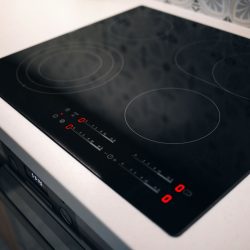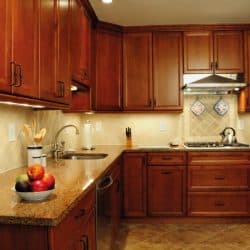How many inches of clearance should you leave between an over-the-range microwave and the stove cooktop?
Microwave ovens are a popular feature of American kitchens and as we add more appliances, many homeowners turn to Over-The-Range microwaves as a space-saving option.
Different manuals and installers give different advice. But accurate clearance between stove top and microwave is crucial to prevent heat damage and allow proper functioning.
By studying measurements from leading brands such as Whirlpool, GE, and Maytag, consulting professional installers, and poring over building codes, we have the expert answers you need.
In this article, we'll explain the ideal over-the-range microwave clearance, the factors involved, and how to safely install it. Let's get cooking!
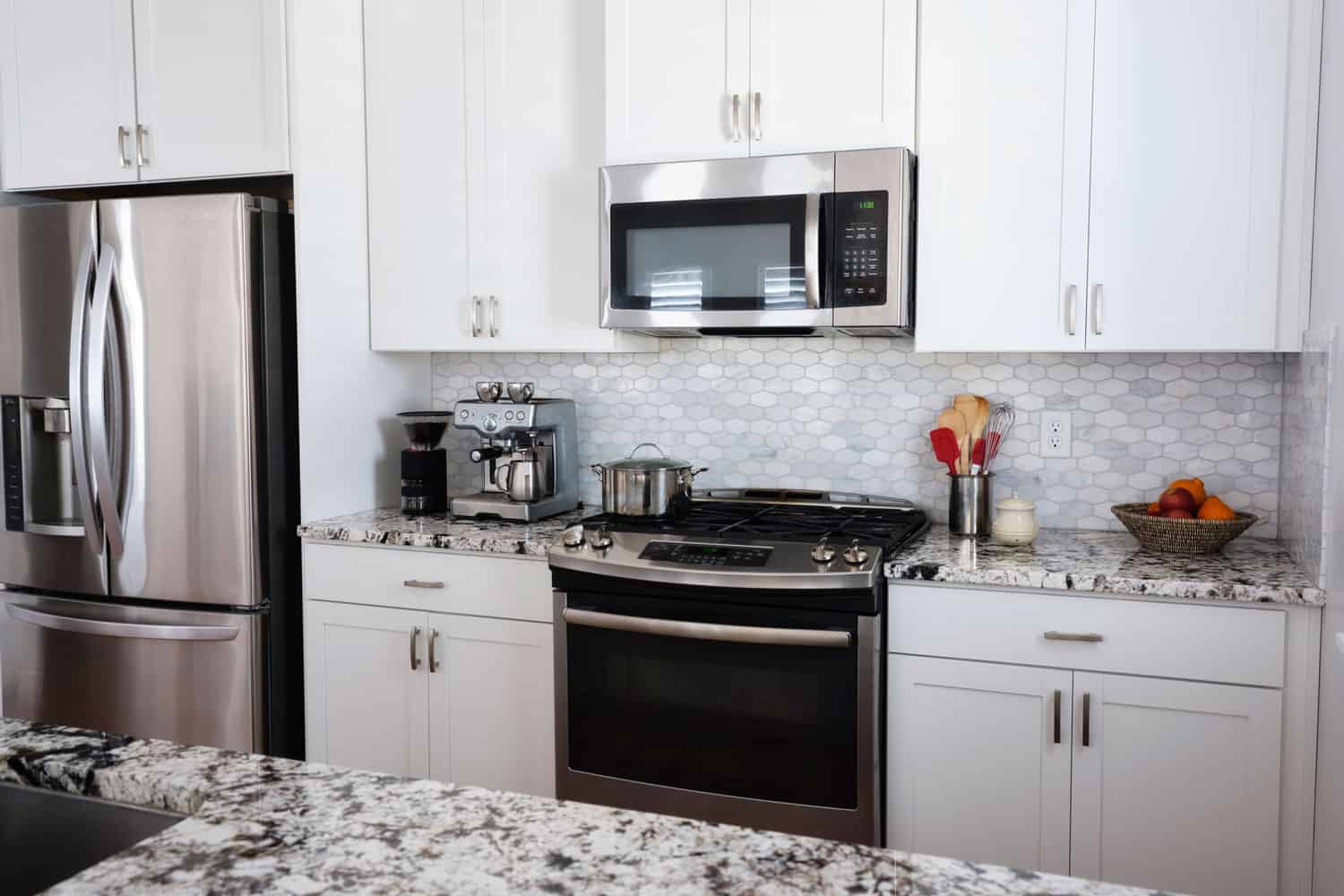
What is an Over-the-Range Microwave?
An over-the-range (OTR) microwave is a microwave oven designed to be installed above a stove or cooktop. OTR microwaves have a shorter, wider shape to fit in the space between kitchen cabinets.
The main features of over-the-range microwaves include:
- Venting system - OTR microwaves include a vent and fan to capture steam, smoke, and odors from cooking below. This replaces the need for a separate range hood.
- Heat tolerance - OTR models are built to withstand heat rising from the cooktop below. They are tested to handle temperatures up to 200°F.
- Placement - OTR microwaves are meant to be installed 15-30 inches above the cooking surface, secured to cabinets or wall.
- Dimensions - To fit above stoves, OTR microwaves are wider and shorter than countertops. Typical size is 29-30 inches wide by 15-16 inches tall.
- Output - OTR models have cooking power comparable to countertops, generally 700-1000W.
Over-the-range microwaves are specifically designed for placement above a stove. Their ventilation, dimensions, and heat tolerance make them ideal built-in appliances to maximize space over the cooktop.
Over-The-Range Microwave Clearances
When installing an over-the-range microwave, proper clearance from the cooktop is important. Manufacturers typically recommend having at least 13-14 inches of clearance between the bottom of the microwave and the top of the stove.
| Brand | Minimum Distance (inches) | Reference |
| Whirlpool | 12-13 | Reference |
| GE | 13 | Reference |
| Maytag | 12-13 | Reference |
| Samsung | 13.5 | Reference |
However, this minimum recommendation does not account for the height of pots and pans used for cooking. With large cookware, an ideal clearance is 18 inches or more from the stovetop to the bottom of the microwave. This allows more heat dissipation from the cooktop.
A good guideline is to have 66 inches of total height from the floor to the top of the over-the-range microwave.
Given standard appliance heights of around 36 inches for stoves and 15 inches for microwaves, this would result in approximately 15-17 inches of clearance between the appliances.
Those who use extra tall cookware might consider buying shorter stove and microwave units to allow for their needed clearance. Always check the appliance manuals for specifications too.
Proper over-the-range microwave placement depends on kitchen layout, appliance heights, ventilation needs, and cookware. But generally, allow for 15-18 inches or more of clearance from the cooktop for safe, convenient cooking.
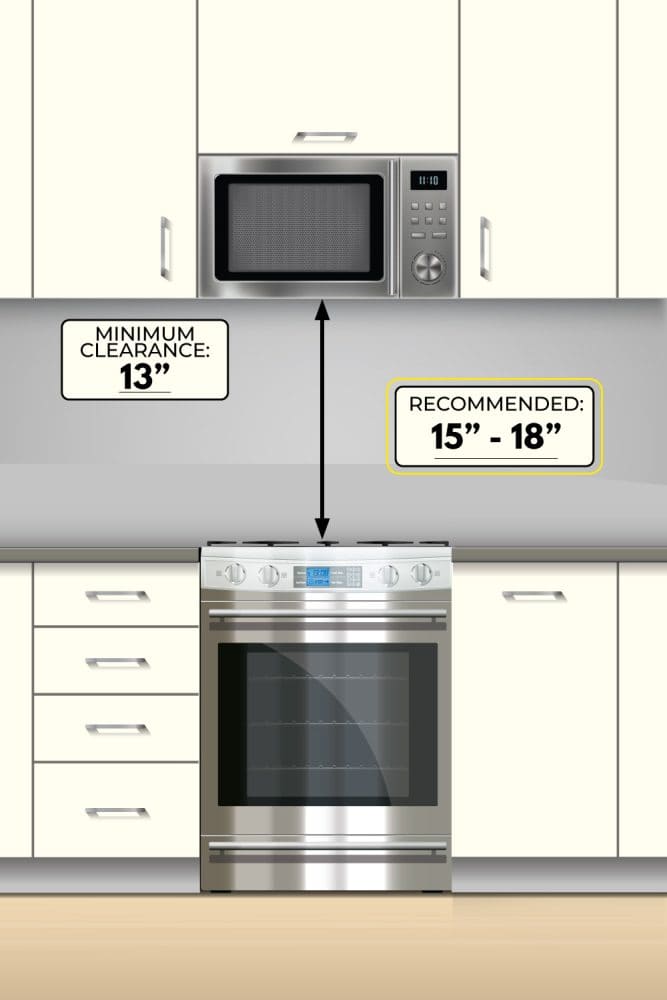
What Do Building Codes Say About Microwave Installation?
When putting your microwave above the stove, you'll want to check local building codes. But most codes actually don't give exact rules. Instead, they tell you to follow the appliance manufacturer's instructions.
These instructions usually recommend:
- The top of the microwave should be about 66 inches off the floor. This leaves good clearance between the microwave and stove for safety.
- The bottom of the microwave shouldn't be higher than 54 inches from the floor. That's so people don't have to reach too far overhead and risk burning themselves.
In fact, even the International Residential Code and the National Kitchen and Bath Association point to appliance manuals for help on microwave height. While neither provides a local building code requirement, their guidelines reflect the lack of such codes in many areas in the United States.
The Kitchen and Bath Association especially says 54 inches is the max height. With a typical 36-inch high stove, that gives you 18 inches of room between the appliances.
The bottom line is to check your local codes and manual. If your installation violates codes, you could get in trouble. When unsure, get professional help or call your building department.
Considerations by Stove Type
Over-the-range microwaves generally work best with electric cooktops, as they produce less heat and allow for the needed overhead clearance.
For gas stoves, which produce more heat, a countertop or built-in microwave placed elsewhere in the kitchen may be a better option. The extra heat output from a gas cooktop often makes it difficult to maintain the proper clearance with an over-the-range microwave.
Checking the stove manual for BTU output and heat levels can help determine if an over-the-range microwave will work with a gas cooktop or if an alternate placement is better. But in general, electric stoves pair more easily with over-the-range microwaves, while gas stoves may necessitate a countertop or built-in model placed in a different location.
Installing an over-the-range microwave
Installing an over-the-range microwave is an advanced DIY project with potentially serious risks if not done properly.
Given the weight of the appliance and the heat and electricity involved, it is highly recommended to hire a professional installer unless you have significant experience with home electrical and construction projects.
Attempting to install an OTR microwave on your own has hazards, including electric shock, microwave detachment, and improper ventilation.
Unless you are completely confident in your abilities, the cost of professional installation is worth it for safety and proper functioning.
If you do choose to self-install, be sure to fully read the manufacturer's instructions and have another person assist you.
Avoid improvising - carefully follow all directions and use all brackets and supports. Rushing or errors could lead to dangerous outcomes. Take time to be thorough and safe.
Over-the-Range Microwave Installation Steps
If using professional installers, understanding the process can help you plan and communicate. Key steps include:
- Assess space - Installers will measure the space between cabinets and between cooktop and ceiling to ensure sufficient room for the microwave model.
- Mount back plate - A sturdy metal plate will be screwed into the wall studs behind the microwave for support. This must be perfectly level.
- Mark and drill holes - Using a template, installers will mark and drill holes for screws going into studs and toggle bolts going into drywall.
- Cut vent and cord holes - Any needed openings will be cut into the upper cabinet for the exhaust system and power cord.
- Attach microwave - With an assistant, installers will carefully lift the microwave into place, engage it with the back plate, and bolt it to the upper cabinet.
- Connect venting - The venting ductwork will be attached to route fumes outside, either through the roof or wall.
- Verify installation - Installers should confirm the microwave is secure, level, and functioning properly before leaving.
- Cleanup - Installers should clean up all sawdust and debris when finished.
Understanding the full installation process ahead of time allows you to be an informed consumer. Be sure to use experienced professionals for this challenging home project.
What is the difference between over-the-range and built-in microwaves?
While both styles of microwaves are meant to save valuable countertop space, they have some differences.
Over-the-range microwaves are dual-purpose. These appliances are not only microwave ovens, but they also serve as alternatives to ventilation hoods for the stove.
Built-in microwaves are essentially countertop models that have been safely secured inside a cabinet or installed in available wall space.
While these do save you a lot of countertop space, they can be pretty tricky to install. It's recommended that you have a licensed professional tackle this task if you're a novice at electrical work.
Can steam (from the stovetop) damage a microwave?
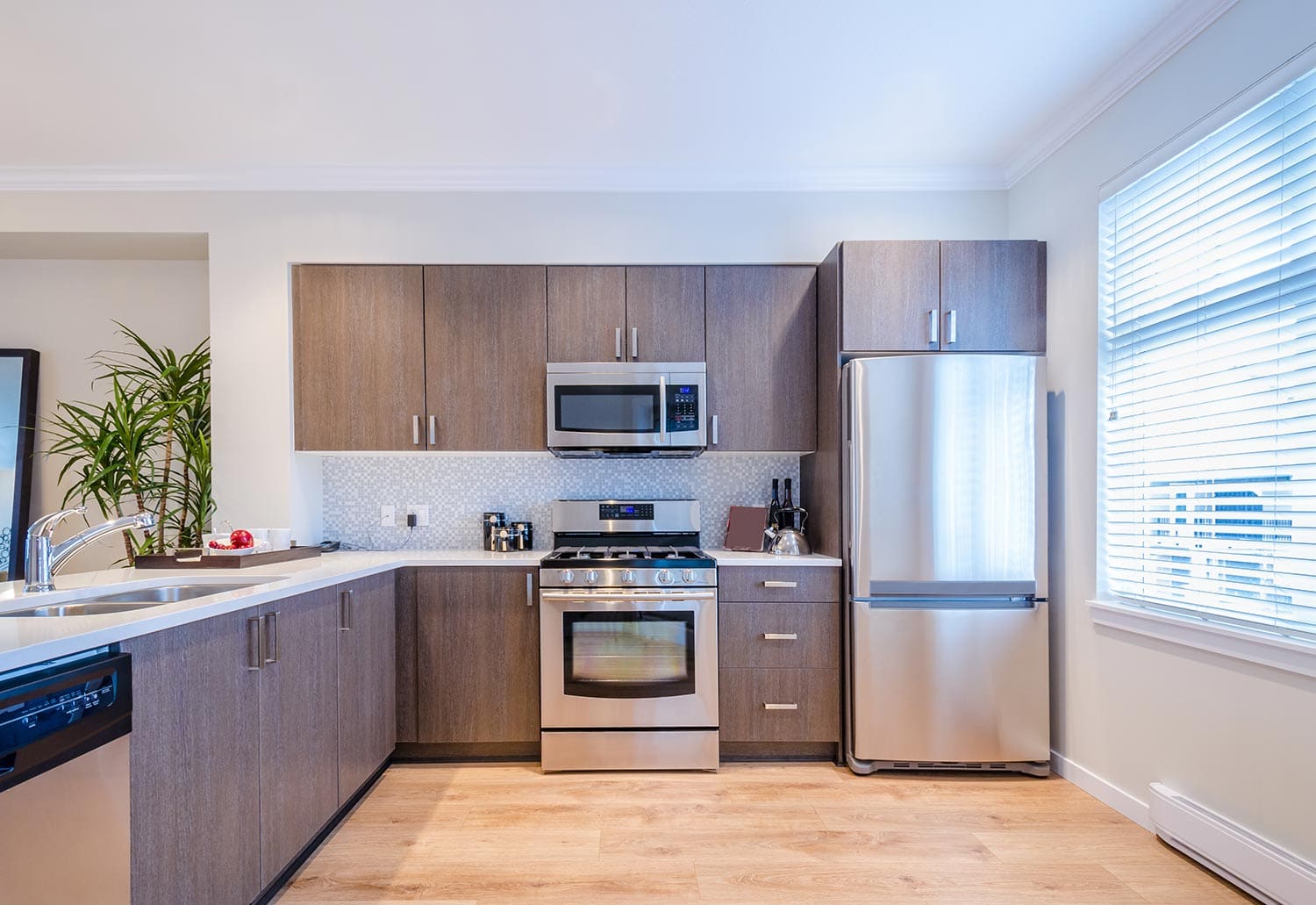
Too much of anything can damage even the most durable appliance. What should we know about steam from the stovetop and what it can do to a microwave installed above it?
Generally, the steam that's emitted from your pots and pans won't be near enough to do damage to your over-the-range microwave. You might notice some steam causing the buildup of water droplets on the door of your microwave, but this can be easily remedied by wiping them off with a soft cloth.
In rare cases, steam can pass through the microwave door, causing the glass to fog. This is because air freely passes through the specially made glass doors of these appliances. If this happens to you, open the door to the microwave for five minutes or so. This will cause the moisture in the glass door to evaporate.
Popular Brands for Over-The-Range Microwaves
When researching over-the-range microwaves, some household names frequently come up. Whirlpool, GE, LG, Frigidaire, and Sharp are among the major appliance brands that manufacture OTR microwaves.
Each brand offers a range of over-the-range models in different sizes, power levels, and feature sets. Prices can range from budget models under $200 to high-end options over $500.
While we can't recommend specific models, these brands are generally known for quality and performance in home appliances.
Checking professional reviews and customer ratings can help narrow down the best choice within each brand's OTR microwave selection.
Be sure to compare dimensions, power, cooking features, venting, and aesthetics to find the perfect over-the-range microwave for your kitchen and budget.
With some research, you can identify the ideal brand and model to meet your cooking needs.
Distance between OTR Microwave and Stove Top: A Recap
Maintaining the recommended minimum distance between appliances is critical for safety reasons and for allowing proper flow inside your working kitchen.
While leading brands recommend a minimum of 13-14 inches between the stove top and your ORT microwave, you should try and aim for 15-18 inches of clearance.
And remember, before you install any appliance, be sure to read the owner's manual carefully.
If you found this post on stoves to be informative, we believe you'll find the following posts on kitchen appliances to be helpful:
What Is The Standard Depth Of A Range?
Are you using Pinterest? Here's an image you can use to pin this article -
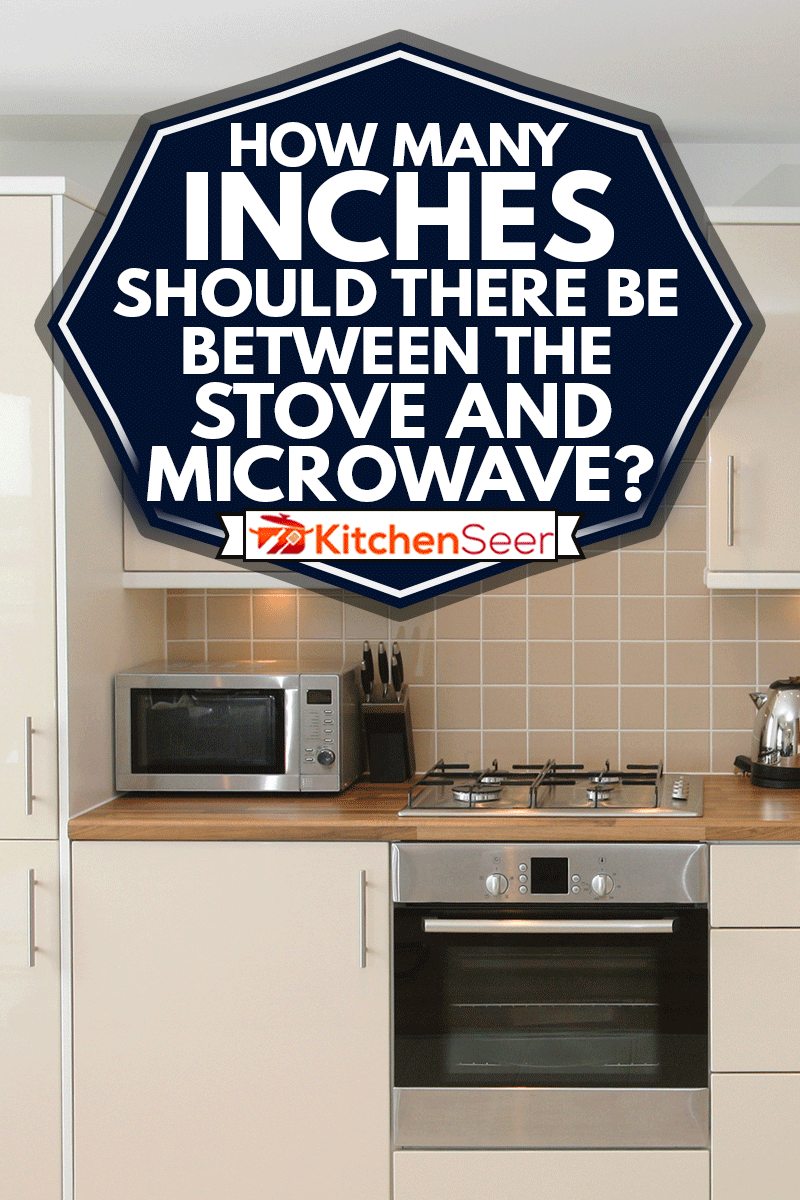

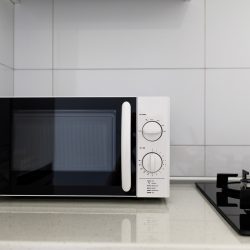
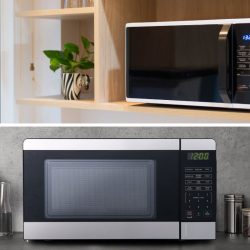
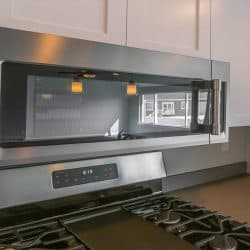
![A small modern kitchen with oak cabinetries, white floating cabinets, and a microwave on top of the countertop, How Big is a Microwave? [By Type]](https://kitchenseer.com/wp-content/uploads/2021/08/A-small-modern-kitchen-with-small-oak-cabinets-white-floating-cabinets-and-a-microwave-on-top-of-the-cooktop-250x250.jpg)
